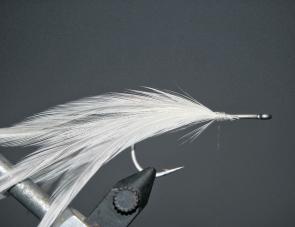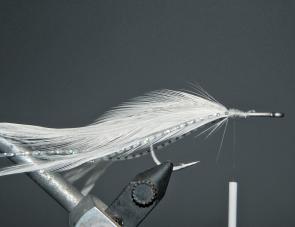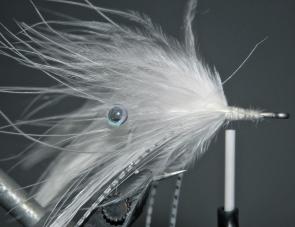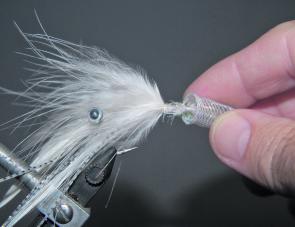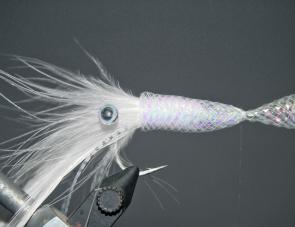During the cooler months, when westerly winds promote high water clarity, squid are a prominent species around the shallows of southern Queensland waters. However, throughout most of the year, squid of varying species can be found in more open waters, channels and reef areas.
A human delicacy of note, squid also form a major food source for many different estuarine species. It stands to reason therefore, that squid patterns are a worthwhile addition to any serious saltwater flyfisher’s box. This month’s pattern is one I have slightly altered after borrowing the basics from the house of Fulling Mill, one of the world’s largest and oldest manufacturers of commercial fly patterns. The Eezee Squid is a fairly simple yet strikingly realistic squid pattern that you will enjoy tying and love fishing.
Squid and other members of the cephalod family can be found in waters ranging from the shallow reef, rock, rubble and weed-lined foreshores to well past the Continental Shelf. Some species grow no more than a few centimeters in length while others exceed several metres.
The three prominent species that I am aware of in my local waters are bottle squid, arrow squid and tiger squid. While I am happy to tuck into a plate of these tasty cephalods, so too are a broad array of fish species. Everything from bream to billfish will readily target squid during their ongoing feeding ritual.
Observing how a squid swims will help you to work out a good stripping combination to breathe life into your Eezee Squid. Squid will dart forward abruptly at the slightest indication of danger but will also hover and move in a slow and non-erratic manner at times. Naturally when faced with a predator, a squid will move quickly with constant darting motion, which is easy to copy with a strip and pause combination. Other retrieves can include a slow mending style retrieve which will produce an action similar to that of a squid slowly working over an area looking for prey. A long single strip and sizeable pause will also work well.
Squid patterns are additionally ideal for situations where you are retrieving against the current and want to occasionally let the pattern drift backwards to the strike zone. Squid can swim both forwards and backwards so this approach appears realistic.
The material list for the Eezee Squid is fairly basic and most should be relatively easy to source. The body is formed from Tiewell Cyber Tube, a woven tubing made from monofilament and flat mylar tinsel. Another substitute could be mylar tubing or EZ Body tubing.
For the main head, marabou is used however polar fibre would also substitute well, although this is sometimes prone to tangling with the hook point.
Saddle hackles are used for tentacles and I can think of no better commercially available substitute. However, I have seen thin latex, mainly sourced from surgical gloves, shaped and used to good effect.
The candles (the squids grabbing tentacles), are represented by barred Sili legs however there are several ways you could make your own representations from other materials.
The eyes I have used in this pattern are Mango Fishing Stalk Eyes, a very realistic representation of cephalod eyes that suit this pattern very well and are easy to use. You could produce your own eyes for this pattern in a similar manner to those tied in the original pattern by Fulling Mill. By placing a small black bead over some heavy clear monofilament and gluing it in place, or melting the mono to secure the bead, you can produce an easy and inexpensive alternative.
The hook pattern chosen here is a Varivas 2610 ST-V however most O’Shaunnessy and 4X long hooks would suffice.
For added durability, you could coat the Cyber Tube with some soft body, epoxy or softex.
(1) Place the hook firmly in the vice and then attach the thread with a jamb knot approximately half way along the hook shank. Cut three thin saddle hackle tips approximately 1.5 times as long as the hook and tie in all on one side of the shank with the natural curvature facing downwards. Repeat the process on the other side then whip finish and add some vinyl cement to thread.
(2) Cut four strands of Sili legs, all approximately twice the length of the hook. Tie two in on each side of the hook shank as done previously with the hackles.
(3) Cut the softest fibres from the side of the marabou plume from down towards the butt of the feather and tie these in at the same tie in point. You are best to do a couple of ties to form an even marabou skirt around the hook shank instead of a single tie. Whip finish and add a little vinyl cement to the tie.
(4) Take your stalk eyes and bend the eyes 90º so they now face outwards from the stalk. Secure the stalk at the same tie in point, so that the pupil is positioned just behind the rear of the hook. Place one eye on each side of the hook shank. Secure and cut away the remaining stalk. Whip finish and add a little vinyl cement to the tie.
(5) Place the end of the Cyber Tube over the eye of the hook and then secure it a few millimeters behind the hook eye. This will be a little awkward especially if you have a long piece of Cyber Tube to deal with and need to backhand tie. Start with loose wraps and tie a little firmer with each wrap so the tubing doesn’t bunch at the tie in point. Whip finish, cut away the thread and add a little vinyl cement. Push forward to invert the tubing and begin forming the body.
(6) Invert the tubing until it is approximately up to a point opposite the barb. Hold the end of your thread so you are able to reattach it over the tubing, just behind the hook eye. Again start with loose wraps and get firmer with each progressive one until the Cyber Tube is tied in evenly and firmly. Whip finish and add a little vinyl cement.
(7) Trim away the remaining tubing as close as possible and then use subsequent thread wraps to cover the final strands of tubing. Whip finish, trim away the remaining thread and add some vinyl cement. You can coat the tubing with some softex, UV epoxy or soft body for increased durability.
Your Eezee Squid is now ready to sucker some cephalod snavelling species into striking.
MATERIALS
HOOK: Varivas 2610 ST-V #1
THREAD: Mono – fine
TENTACLES: Saddle hackle tips – white
CANDLES: Sili legs barred – pearl silver
HEAD: Marabou – white
EYES: Mango Fishing Stalk Eyes – 5mm skygh
BODY: Cyber Tube – maxi pearl
FINISH: Vinyl cement
Reads: 1763